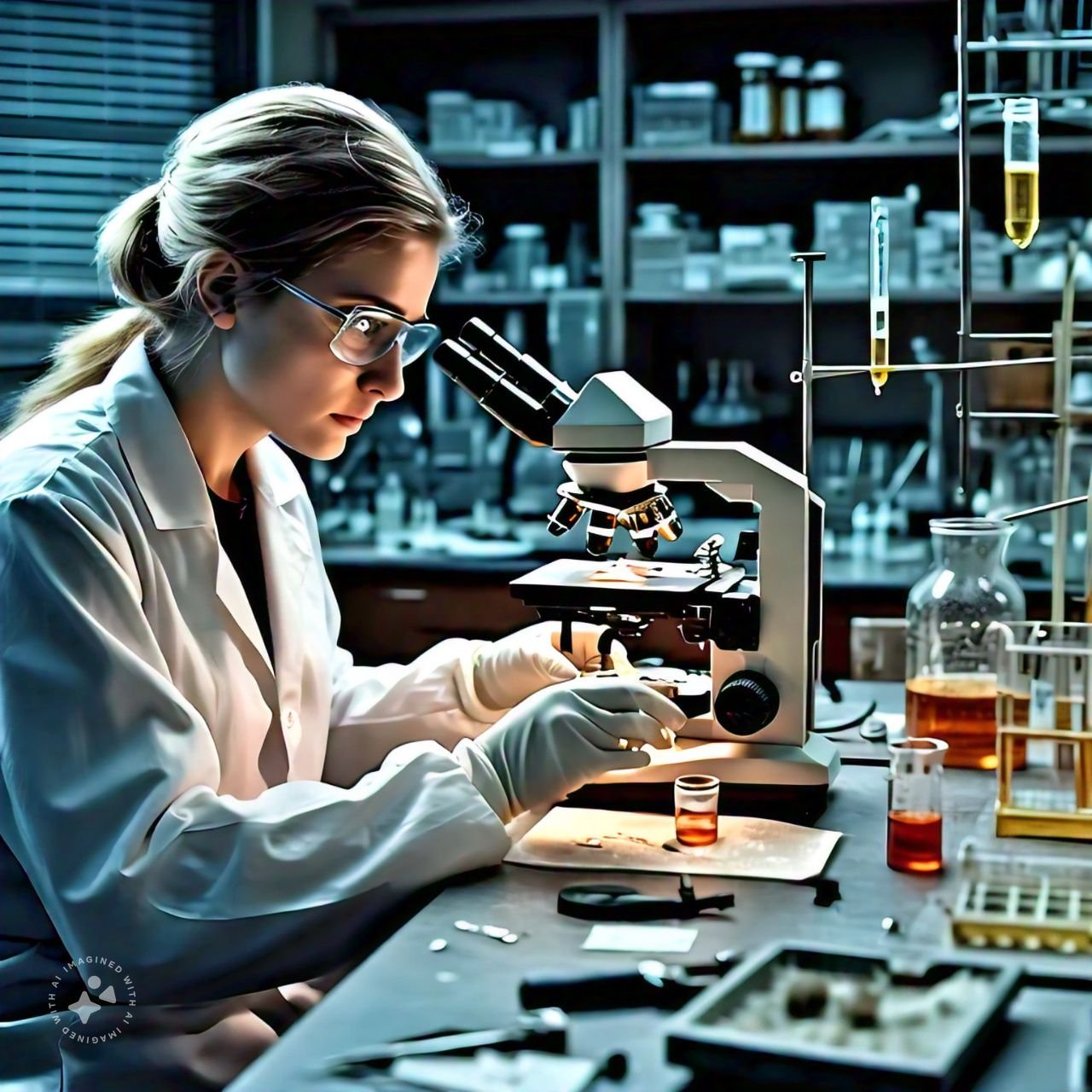Forensic Science Experiments Secret of Crime Scene Investigation

Introduction
Modern criminal investigations rely on forensic science experiments and scientific methodology. Using crime scene evidence, forensic professionals assist law enforcement identify culprits, exonerate the innocent, and assure justice. Each forensic science profession has its own tests and methods for solving crime scenes. This article discusses the many forensic science tests used to solve crimes and their influence on criminal investigations.
Crime Scene Investigation: The Foundation of Forensic Science
Criminal scene investigation (CSI) is the first and most important phase in forensics. The method entails carefully gathering, conserving, and evaluating crime scene evidence. Forensic professionals use photographs, sketches, and physical evidence to document and examine the scene. They should keep all evidence to prevent contamination and loss.
A secure crime scene boundary is essential to CSI. This requires blocking illegal access and allowing only trained staff in. Forensic professionals reduce the possibility of evidence tampering or destruction.
After setting the perimeter, forensic investigators collect evidence. Investigators identify and document fingerprints, blood stains, hair, fibers, and trace items. They use specialized methods to collect each piece of evidence without contamination. To maintain integrity, they take blood samples with sterile instruments and preserve them properly.
CSI analyzes and interprets evidence using physical evidence and forensic experiments. These tests aim to illuminate the crime, the offender, and the chain of events. By applying scientific principles to evidence, forensic professionals can rebuild the crime scene and comprehend what happened.
Forensic Biology: Unlocking the Secrets of Biological Evidence
Forensic biology examines biological evidence, such as blood, hair, and body fluids. Researchers use various studies and methods to detect biological components and demonstrate their criminal significance.
Blood analysis is a popular forensic biology technique. Blood samples are tested for type and pollutants. ELISA and PCR are used by forensic scientists to identify proteins and DNA in blood samples. These tests can reveal the blood’s origin and felony relevance.
Another significant part of forensic biology is hair analysis. Forensic specialists can identify human or animal hair and establish if it was forcefully removed by microscope. Additionally, forensic biologists utilize chemical analysis to detect drugs or poisons in hair samples. This information can illuminate a crime.
Forensic Chemistry: Analyzing Chemical Evidence
Forensic chemistry analyzes crime scene chemicals. This discipline of forensic science experiments uses various tests and methods to detect and measure chemical components, revealing the crime.
Drug evidence analysis is a common forensic chemistry experiment. GC-MS and HPLC help forensic chemists identify and measure drugs and their metabolites. These approaches allow forensic professionals to detect certain drugs and their concentration, which is critical in drug investigations.
An essential part of forensic chemistry is explosives and gun analysis. SEM and FTIR are used by forensic chemists to evaluate explosives and gunshot residues. Using these traces, forensic scientists can identify the explosive or firearm used and link it to a crime.
Forensic chemistry analyzes paint, glass, and fibers like trace evidence. Forensic chemists can link evidence to the crime scene by comparing its chemical makeup to known samples. This analysis can reveal the perpetrator’s movements.
Forensic Toxicology: Detecting Poisons and Drugs
Forensic toxicology detects and analyzes poisons, drugs, and other compounds in biological samples. This area is vital for detecting death causes and identifying crime-related chemicals.
Drug and toxin testing in blood and urine samples is a common forensic toxicology experiment. Forensic toxicologists identify and quantify biological fluid contaminants using immunoassays and mass spectrometry. These tests can reveal if a person died from drug use or hazardous exposure.
Forensic toxicologists test autopsy tissue for drugs and toxins. Forensic professionals can determine the kind and concentration of a drug in tissue samples, revealing the cause of death and the crime.
In addition to identifying drugs and chemicals, forensic toxicologists research their impact on the body. This involves studying how chemicals interact and how they may have caused the victim’s illness or death.
Forensic Odontology: Identifying Victims Through Dental Records
Forensic odontology uses dental records and bite marks to identify people and assess injuries. This discipline of forensic science experiments is vital in unidentified remains and biting damage situations.
Comparing dental data and remains is a common forensic odontology experiment. Forensic odontologists use dental x-rays, photos, and charts to identify people by their dental traits. By comparing these records to dental remains, forensic professionals can confirm or deny identities.
Forensic odontology analyzes biting marks. Forensic odontologists can assess bite size, shape, and pattern from bite marks on victims or crime scene artifacts. In assault or abuse instances, this information can identify the culprit and give proof.
Forensic odontologists investigate dental injuries and identify victims by studying bite marks. Forensic professionals can determine the cause of dental injuries by comparing them to trauma patterns.
6 Forensic Pathology: Determining the Cause of Death
Forensic pathology examines corpses to determine cause of death. Forensic pathologists evaluate deaths and give vital information for criminal investigations.
The autopsy is a key forensic pathology experiment. Forensic pathologists examine the corpse outwardly and inside during an autopsy to find symptoms of trauma, sickness, or other causes of death. To ascertain the cause of death and underlying diseases, organs, tissues, and physiological fluids are examined.
Forensic pathologists analyze tissue and fluid samples for drugs, poisons, and other chemicals that may have caused death. Forensic professionals can determine the cause of death by integrating these data with the autopsy.
In addition to diagnosing the cause of death, forensic pathologists investigate suspicious or atypical deaths. This covers suicide, homicide, and accidental fatalities. By offering expert testimony and analysis, forensic pathologists help law enforcement and legal experts comprehend the death and its relation to the inquiry.
Forensic Entomology: Using Insects to Estimate Time of Death
The study of insects in crime scene investigations is forensic entomology. Forensic entomologists estimate death time and crime scene circumstances by examining insect activity and development.
The collecting and identification of crime scene insects is a major forensic entomology project. During forensic entomology, insects are identified, their development, and their body locations. Based on insect life cycles, this knowledge can determine death time.
Forensic entomologists analyze temperature, humidity, and decomposition rates, which impact insect activity. By knowing how these elements affect insect growth, forensic professionals may improve their death time predictions and give more reliable evidence.
Forensic entomologists investigate various crime scene characteristics in addition to calculating death time. Insect evidence is used to locate the body, other creatures, and signs of manipulation or disruption.
Forensic Anthropology: Identifying Human Remains and Analyzing Trauma
Human skeletal remains are used in forensic anthropology to identify people and investigate trauma. This discipline of forensics is vital in misidentified or deteriorated remains investigations.
Skeletal remains are examined in forensic anthropological experiments. Forensic anthropologists use bone structure, size, and morphology to estimate age, sex, ancestry, and height. This information can assist identify the deceased and reveal their dying circumstances.
Forensic anthropologists examine skeletal injuries for indicators of abuse or damage. Fractures, lesions, and other bone marks can help forensic professionals pinpoint the trauma’s source. This information can assist police and lawyers investigate the death and identify suspects.
Forensic Document Examination: Analyzing Handwriting and Documents
Forensic document examination examines handwriting, papers, and other written items for authenticity and forgeries. Cases involving contested signatures, falsified papers, and other textual evidence depend on this field of forensic science experiments.
Handwriting analysis is a common forensic document experiment. Forensic document examiners compare handwriting samples to recognized examples for distinctive characteristics and patterns. This involves checking the writing’s slant, size, pressure, and spacing for authenticity and authorship.
Forensic document examiners examine print and typed documents for forgery or manipulation. They should examine the document’s typography, ink, and paper for inconsistencies and anomalies. Scientific methods can help forensic document examiners determine the origins and validity of written documents.
Besides handwriting and document analysis, forensic document examiners investigate digital documents and emails. Forensic professionals detect digital evidence and aid criminal investigations by using comparable methods.
The Role of Technology in Forensic Science
Technology has greatly improved forensic science tests and analysis. Technology is essential in modern forensic investigations, from advanced analytical tools to software.
Automated analytical equipment are a major forensic science technical accomplishment. As DNA sequencing, mass spectrometry, and gas chromatography have evolved and automated, forensic professionals can examine samples more accurately and quickly. These tools give precise evidence composition and features, improving accuracy and turnaround time.
Digital techniques and software have transformed forensic science alongside analytical instruments. Forensic professionals analyze computer data, emails, and social media information using sophisticated tools. These technologies help forensic specialists retrieve, evaluate, and present court-admissible digital evidence.
Technology helps visualize and recreate crime scenes. 3D modeling, virtual reality, and other visualization methods let forensic professionals recreate crime scenes. These techniques assist detectives grasp the scene, evidence, and narrative, revealing the crime’s character.
Conclusion
Forensic science experiments tests help solve crime scenes and aid criminal investigations. Forensic professionals study evidence, recreate events, and identify culprits using scientific methods to secure justice. From crime scene investigation to specialized examinations of biological, chemical, and physical evidence, forensic science uses a wide range of studies and procedures to solve crimes and reveal the truth. As technology advances, forensic science will gain more sophisticated tools and methodologies for revealing crime scene secrets and delivering justice.
FAQs
What is forensic science?
Forensic science solves crimes and legal concerns using science. Biology, chemistry, and physics are used to assess evidence and generate legal insights.
Why are forensic science important?
To assess crime scene evidence,forensic science experiments tests are essential. Biological samples, fingerprints, and trace evidence can identify suspects, establish timeframes, and disprove alibis.
How is forensic science conducted?
Forensic science collects evidence from crime scenes, prepares samples, and evaluates them using scientific methods. Results are analyzed, recorded, and utilized in investigations and lawsuits.
Is forensic science always accurate?
Forensic science is accurate but not perfect. Contamination, human mistake, and technical constraints might alter outcomes. To reduce mistakes and assure dependability, strict processes and quality control are in place.
Can forensic science be used in court?
Forensic scientists regularly use experiments, studies, and results in court to support legal claims.. Forensic specialists may testify about their findings and techniques.










